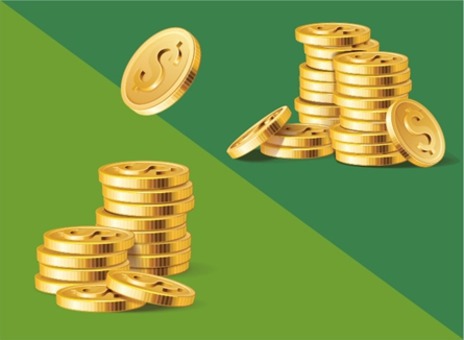In 1956, John Kelly of Bell Labs derived a formula for figuring out how much to bet when you are favored to win but it is not a sure thing. In an even-money bet, if your probability to win is q, then the criterion says to bet the fraction 2q -1 of your capital. For example, if you have a 0.55 chance of winning, you should bet 1.1 – 1 or 10% of your money.
Something like this should make intuitive sense. You do not want to bet everything when it is not a sure thing, but you want to bet more when the odds are more in your favor.
Even if the probability of winning is even, it may be worth betting something if the payout is high enough. For that case, Kelly derived the formula that the best fraction to bet is p – (q/b) where p is the probability you win, q = 1 – p is the probability you lose, and b is the payout ratio. For example, if your probability to win is 0.5 but you get paid $3 for every bet of $2, then b = 1.5 and the Kelly fraction is 0.5 – (0.5/1.5), which is 16.666 … %.
Suppose your goal is to double your money in a given number of rounds with the highest probability.
Warm-Up: If you have just two rounds available to you and a payoff of b = 1.5, then what is good strategy?
Solution: If you bet too little, then you must win twice in a row. For example, if you bet $30 in the first bet and win you will receive $45, but then you must bet at least 30% of that to get to $200. On the other hand, if you bet say $70, then you will get over $200 if you win the first time. That brings your odds to approximately 1/2.
So, if your goal is to double your money, then you should bet more if there are very few rounds available to you and then stop when you achieve your goal. This does not accord with the Kelly criterion because the goal is to achieve a certain goal in a limited number of rounds.
Warm-Up 2: If you have three bets available to you with a payout of 1.5 each time, then can you do better than 1/2 odds?
Solution: Yes. If you bet $67 the first time and you win, then you are done because your payout 67 x 1.5 > 100. Moreover you can win even if you lose that first time if you bet everything on the last two bets. Here is why. You will have $33 after the loss of the first bet and then you will bet all $33 and will win $49.5 to give you a total of $82.50. If you bet all $82.50 and win, your payout will be $123.75 and that will put you over $200. So your odds of winning are 1/2 + 1/8 or 5/8.
The trouble with the preceding strategy is that you could end up with nothing, so for the questions below, fix the fraction of your capital to bet each round. For example, you might always bet x% of your capital, until either you reach the end of the rounds or you reach your doubling goal at which point you will stop. Call this the Fixed Fraction and Stop method.
Question 1: Assume you have a maximum of 10 rounds available and your probability of winning each round is 0.5 but the payout is 1.5 as in the Warm-Ups. Using the Fixed Fraction and Stop method, what fraction of your capital should you bet each round that gives you the highest probability of doubling your money? Also, what is the probability of winning in that case?
Solution: The best fraction is about 0.67 of the capital that you have before each round (and of course stop if you in fact double your money). Your probability of doubling in that case is about 0.614. Interestingly, the strategy of the second Warm-Up for three rounds gave a doubling probability of 5/8 or 0.625. Being willing to go for broke can help the probability if there is a fixed final goal.
Question 2: Assume the same setup as Question 1, but now you have 100 rounds. Using the Fixed Fraction and Stop method, what fraction of your capital should you bet each round that gives you the highest probability of doubling your money? Also, what is the probability of winning in that case?
Solution: The best fraction is about 0.11 of capital and you would have nearly a 92% chance of doubling your money.
Question 3: Assume the same setup as in question 2, again with 100 rounds and 3 for 2 payoff, but now your probability of winning each round is only 0.45. What fraction should you use then in a Fixed Fraction and Stop method? What is your probability of doubling?
Solution: The best fraction in this case is about 0.14 with a 71% chance of doubling your money.

Upstart: The probability of winning is not usually fixed nor is the payout. Given a sequence of winning probabilities and payouts that you know in advance, what should you bet each time to maximize your probability of doubling your money in a scenario where you are willing to lose all your money when trying?




Join the Discussion (0)
Become a Member or Sign In to Post a Comment